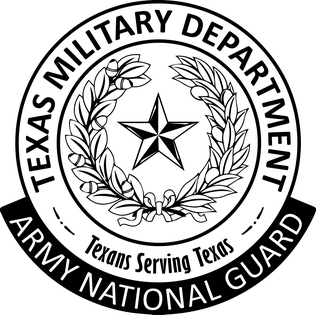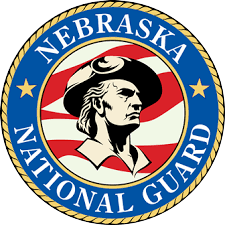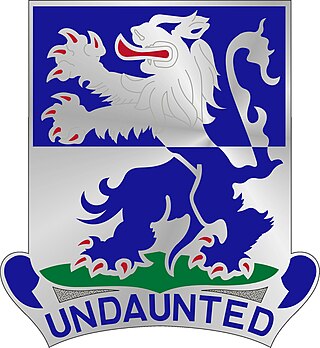
The Army National Guard (ARNG), in conjunction with the Air National Guard, is an organized militia force and a federal military reserve force of the United States Army. They are simultaneously part of two different organizations: the ARNG of each state, most territories, and the District of Columbia, as well as the federal ARNG, as part of the National Guard as a whole. It is divided into subordinate units stationed in each state or insular area, responsible to their respective governors or other head-of-government.

The VII Army Corps of the United States Army was one of the two principal corps of the United States Army Europe during the Cold War. Activated in 1918 for World War I, it was reactivated for World War II and again during the Cold War. During both World War II and the Cold War it was subordinate to the Seventh Army, or USAREUR and was headquartered at Kelley Barracks in Stuttgart, West Germany, from 1951 until it was redeployed to the US after significant success in the Gulf War in 1991, then inactivated in 1992.

The 35th Infantry Division, formerly known as the 35th Division, is an infantry formation of the United States Army National Guard headquartered at Fort Leavenworth, Kansas.

The 31st Infantry Division ("Dixie") was an infantry division of the United States Army National Guard, active almost continuously from 1917 to 1968. Composed of men from Alabama, Florida, Georgia, Louisiana, Michigan, Illinois, and Mississippi at various points in its existence, the division saw service in both World War I and World War II, and was mobilized during the Korean War, although it was not sent overseas in the latter.
Reconnaissance, surveillance, and target acquisition (RSTA) groups the tasks of reconnaissance, surveillance and target acquisition conducted by the Department of Defense. RSTA supports military operations at a strategic, operational, or tactical level, either by dedicated RSTA forces or those which possess the capability.

The New York Army National Guard is a component of the New York National Guard and the Army National Guard. Nationwide, the Army National Guard comprises approximately one half of the United States Army's available combat forces and approximately one third of its support organization. National coordination of various state National Guard units are maintained through the National Guard Bureau.

The Texas Army National Guard is a component of the United States Army, the United States National Guard and the Texas Military Forces.

The Nebraska Army National Guard is a group of Army National Guard units in the U.S. state of Nebraska. The Adjutant General for these units is Major General Daryl L. Bohac, who was announced as the new Deputy Director of the Army National Guard in May, 2013, and assumed his new duties later in 2013.

The 177th Armored Brigade is an AC/RC unit based at Camp Shelby, Mississippi. The unit is responsible for training selected United States Army Reserve and National Guard units. The unit was formerly designated as 3rd Brigade, 87th Division. The brigade is a subordinate unit of First Army.

The 142nd Field Artillery Regiment is a United States Army field artillery regiment currently represented in the Arkansas Army National Guard by the 1st Battalion, 142nd Field Artillery, headquartered in Bentonville, Arkansas; 2nd Battalion, 142nd Field Artillery, headquartered in Barling, Arkansas; and Battery F, 142nd Field Artillery stationed in Fayetteville, Arkansas, elements of the 142nd Field Artillery Brigade which is headquartered in Fayetteville, Arkansas. The regiment was created in 1917 from the former 2nd Arkansas Infantry. The 142nd Field Artillery shipped to France during World War I but did not see combat before the cessation of hostilities. The regiment was activated for World War II, but its battalions were redesignated as separate battalions, 1–142nd became the 936th Field Artillery Battalion, the 2–142nd became the 937th Field Artillery Battalion. The battalion's served throughout the European Theater of Operations. The battalions were activated again for the Korean War and served throughout the war. Following the Korean War, the separate battalions resumed their former designations of 1–142nd FA and 2–142nd FA. The 142nd Field Artillery Brigade, including both battalions, was activated for Operation Desert Storm. Elements of the 142nd Fires Brigade have been activated for service in Operation Noble Eagle and Operation Iraqi Freedom. The 142nd Fires Brigade was instrumental in support and recovery operations located in New Orleans, Louisiana after hurricanes Katrina and Rita devastated the Gulf Coast.

In the United States (US) military, a beret flash is a shield-shaped embroidered cloth that is typically 2.25 in (5.72 cm) tall and 1.875 in (4.76 cm) wide with a semi–circular base that is attached to a stiffener backing of a military beret. These flashes—a British English word for a colorful cloth patch attached to military headgear—are worn over the left eye with the excess cloth of the beret shaped, folded, and pulled over the right ear giving it a distinctive appearance.

The 53rd Infantry Brigade Combat Team is an infantry brigade combat team of the Florida Army National Guard. The 53rd Infantry Brigade is the largest National Guard unit in the state of Florida. The brigade was one of fifteen enhanced readiness brigades, designed and trained to support active duty divisions. The brigade includes 32 units in Florida and Alabama with 4,166 authorized personnel.

The 67th Maneuver Enhancement Brigade is a maneuver enhancement brigade (MEB) of the Nebraska Army National Guard. It derives its lineage from the 67th Infantry Brigade (Mechanized), previously a component of the 35th Infantry Division (Mechanized). The brigade has also been organized as an area support group from 2003–2008, and as a battlefield surveillance brigade from 2008–2016.

The 119th Infantry Regiment was an infantry regiment of the United States Army. The unit was an organic element of the 30th Infantry Division of the United States Army.

The 124th Infantry Regiment is a parent regiment of the United States Army, represented in the Florida Army National Guard by the 1st Battalion headquartered in Miramar and 2nd Battalion at Orlando. The two Battalions are elements of the 53rd Infantry Brigade Combat Team.

The 167th Infantry Regiment is an infantry regiment of the Alabama National Guard.
The Combat Aviation Brigade, 42nd Infantry Division is a subordinate command of the 42nd Infantry Division. Once contained solely within New York, force reductions and reorganizations have resulted in units from several different states making up the brigade.
The 117th Field Artillery Regiment is a field artillery regiment of the Alabama Army National Guard. The regiment's 1st Battalion is a cannon battalion assigned to the 142nd Field Artillery Brigade.

The 142nd Field Artillery Brigade is a field artillery brigade in the Arkansas Army National Guard (ARNG). The 142nd is currently under administrative control of the 29th Infantry Division.




















